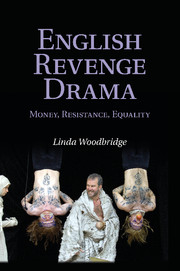Book contents
- Frontmatter
- Contents
- List of figures
- Acknowledgments
- English revenge plays discussed in this book
- Standard MLA abbreviations for Shakespeare's plays
- Note on the text
- PART I RAMPANT REVENGE
- 1 Getting what one deserves
- 2 Can two wrongs ever make a right? Some theory
- PART II ECONOMIC UNFAIRNESS: REVENGE AND MONEY
- PART III POLITICAL UNFAIRNESS: REVENGE AND RESISTANCE
- PART IV SOCIAL UNFAIRNESS: VENGEANCE AND EQUALITY
- Conclusion
- Bibliography
- Index
2 - Can two wrongs ever make a right? Some theory
Published online by Cambridge University Press: 06 December 2010
- Frontmatter
- Contents
- List of figures
- Acknowledgments
- English revenge plays discussed in this book
- Standard MLA abbreviations for Shakespeare's plays
- Note on the text
- PART I RAMPANT REVENGE
- 1 Getting what one deserves
- 2 Can two wrongs ever make a right? Some theory
- PART II ECONOMIC UNFAIRNESS: REVENGE AND MONEY
- PART III POLITICAL UNFAIRNESS: REVENGE AND RESISTANCE
- PART IV SOCIAL UNFAIRNESS: VENGEANCE AND EQUALITY
- Conclusion
- Bibliography
- Index
Summary
And when he had opened the fifth seal, I saw under the altar the souls of them that were slain for the word of God … And they cried with a loud voice, saying, How long, O Lord, holy and true, dost thou not judge and avenge our blood?
Revelation 6: 9–10How bad can vengeance and retributive punishment be when performing them does not sully the hands of God?
Peter A. FrenchJesus Christ is exceeding severe, and just as well as merciful.
T. Collier, 1648Before proceeding to the resentment of unfairness that I think fueled the Renaissance passion for revenge plays, let me address some misconceptions about the cultural role of revenge in this era.
Did revenge make Elizabethans miserable? Jonathan Gil Harris writes of the “physiological damage it was believed to cause the avenger”; it was “a major cause of melancholy” (101). To physiologists, Graham Holderness says, revenge was “psychologically and physically damaging,” an “obsessive passion, which produced symptomatic ill-health and nervous disorders” (51). Its “ravages,” says Prosser, include “deterioration of the mind” (8). Bacon indeed held that “a man that studieth revenge, keeps his own wounds green” (17). But in Senecan tragedy, the frustration of vengeful longings “leaves a person incomplete, as if he were maimed,” and revenge brings “a deep pleasure that Seneca's Medea calls voluptas” (A. Burnett 1–2). And in Renaissance drama, too, revenge is often therapeutic: “Revenge / Must ease and cease my wrongful injuries”; “revenge shall ease my ling'ring grief” (Locrine 3.2.81–82, 3.3.
- Type
- Chapter
- Information
- English Revenge DramaMoney, Resistance, Equality, pp. 22 - 58Publisher: Cambridge University PressPrint publication year: 2010



